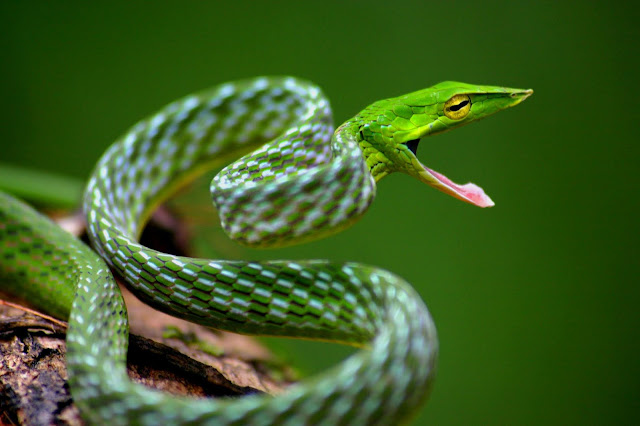Green vine snake is also known as long-nosed whip snake and common vine snake belonging to colubridae family of snakes; it is a slende...
Green vine snake
is also known as long-nosed whip snake and common vine snake belonging to
colubridae family of snakes; it is a slender tree snake which is
green in color. Ahaetulla nasuta is distributed in countries viz., Burma,
Bhutan, India, Thailand, Vietnam, Bangladesh, Cambodia and Sri Lanka.
There are many other vernacular names used for the species in different regions
such as “Pachai paambu” in Tamil and “Shelati snake” in Marathi are among
the lots of other vernacular names for the Green vine snake. The species Ahaetulla
nasuta sometimes confused with the Oxybelis fulgidus species
which is found in Central and South America due to its common name “Green vine
snake". In India the species is
protected under schedule-IV of wild life protection act. The term “Ahaetulla” received
by the species is due to the false belief that it attacks at the eye, as in
Sinhala it means “Eye plucker”.
|
Scientific classification
|
|
|
Kingdom:
|
Animalia
|
|
Phylum:
|
Chordata
|
|
Class:
|
Reptilia
|
|
Order:
|
Squamata
|
|
Suborder:
|
Serpentes
|
|
Family:
|
Colubridae
|
|
Genus:
|
Ahaetulla
|
|
Species:
|
nasuta
|
|
Binomial name
|
|
|
Ahaetulla nasuta, Lacépède (1789)
|
|
Ahaetulla nasuta is a diurnal
species and is mildly venomous. The food of the species mainly contains
frogs and lizards that they hunt by using their binocular
vision, besides also take other small vertebrates. These are among slow moving
serpents which rely on camouflaging. While in threat the snakes expand their
body to display a black and white scale marking with this, they may also open
their mouth as a warning towards the perceived threat. This is the only snake
species having horizontal pupils, comparing to the family of vipers that normal
have vertical slit pupils.
Ahaetulla nasuta, (Lacépède 1789)- Image source: Davidvraju (wikipedia)
The species is viviparous in nature
which gives birth to young’s that grow inside female’s body, surrounded by egg
membrane. They have been considered capable of delaying fertilization as
in reports in the London zoo kept a female in isolation from August, 1885 which
gave birth in August, 1888.
The taxonomy of vine snakes is not very well
acknowledged and literature works also varies widely, but there are around 10
species that are commonly counted under the genus Ahaetulla and those
are: Ahaetulla anomala (Annandale,
1906) - Variable colored vine snake; Ahaetulla dispar (Günther,
1864) - Günther's vine snake or Indian bronze back; Ahaetulla
fasciolata (Fischer, 1885) - Speckle-headed whipsnake; Ahaetulla
fronticincta (Günther, 1858) -Burmese vine snake; Ahaetulla
laudankia, Deepak, Narayanan, Sarkar, Dutta & Mohapatra,
2019 - Laudankia vine snake; Ahaetulla
mycterizans (Linnaeus, 1758) - Malayan green whip
snake; Ahaetulla nasuta (Lacépède, 1789) - Long-nosed
whip snake; Ahaetulla perroteti (Duméril & Bibron,
1854) - Western Ghats bronze back; Ahaetulla
pulverulenta (Duméril & Bibron, 1854) -
Brown-speckled whip snake; and Ahaetulla prasina (Boie,
1827) - Oriental whip snake or Asian vine snake which is further reported
to have 4 subspecies under it viz., Ahaetulla
prasina prasina (Boie, 1827); Ahaetulla prasina medioxima, Lazell,
(2002); Ahaetulla prasina preocularis (Taylor, 1922), and Ahaetulla
prasina suluensis, Gaulke, (1994).
 |
| Ahaetulla nasuta (Lacépède 1789)- Image source: Kalyan Varma (wikipedia) |
Dorsally the species is thin, long having slender
body; dorsal scales are smooth and are obliquely arranged. While the color of
the species found is bluish-green or parrot green; and brown in variability.
There is even black inter-scale form present in tilted style from neck up to
mid body. Over the ventral side belly is entirely yellow-green in color and is
pattern less. Occasional a white or yellow color border separates the dorsal
and ventral surfaces. On the other hand the subcaudal scales are paired in as
crisscross mode. Dorsal scales are arranged in oblique rows of 15:15:13. Anal
divided and are 166-207 in number; sub caudal are 156-180 in
males whereas 135-152 in females and are paired. Snakes have 8 super labials
out of which 5th in contact with eye; lower labials 4 touching the anterior
chin-shields which are shorter than posterior ones; preocular 1; loral absent,
presubocular 1 or 2; postocular 2; temporal 1+2 or 2+2. Head in these snakes are long and distinguishable from neck having
pointed snout. The color of the upper lip is white or yellow. Eyes have
horizontal pupils. While tail in these specimens are very long, thin and
slender tail ends having pointed tip.
As the species is mildly venomous in nature its bite
causes swelling, pain, bruising and numbness in the area of bite and usually
symptoms subsides within 3-4 days. In terms of habitat the species like to be
in low bushes, shrubs and trees in lowland forest ranges at an elevation of
about 1000 m.asl, especial near the streams, rarely can be seen near human
settlements also. There is no local threat is reported
concerning the species expect the declining habitat.
Literature Cited:
Bhattarai,
S., Chiranjibi, P., Pokheral, B.L. and Subedi, N. (2017). Herpetofauna of a
Ramsar Site: Beeshazar and Associated Lakes, Chitwan National Park, Nepal. IRCF
Reptiles & Amphibians, 24(1): 17-29 - get paper here
Bhattarai,
S., Pokheral, C.P., Lamichhane, B.R., Regmi, U.R., Ram, A.K. and Subedi, N. (2018).
Amphibians and reptiles of Parsa National Park, Nepal. Amphibian &
Reptile Conservation, 12(1): 35–48 (e155)
Botejue,
W., Madhava, S. and Wattavidanage, J. (2012). Herpetofaunal diversity and
distribution in Kalugala proposed forest reserve, Western province of Sri
Lanka. Amphibian & Reptile Conservation. 5(2): 65-80(e38).
- get paper here
Boulenger,
G.A. (1890). The Fauna of British India, including Ceylon and Burma. Reptilia
and Batrachia. Taylor & Francis, London - get paper here
Boulenger,
G.A. (1896). Catalogue of the snakes in the British Museum, Vol. 3. London,
Taylor & Francis. - get paper here
Brischoux,
F., Pizzatto, L. and Shine, R. (2010). Insights into the adaptive significance
of vertical pupil shape in snakes. Journal of Evolutionary Biology, 23 (9):
1878–1885.
By
Davidvraju - Own work, CC BY-SA 4.0, https://commons.wikimedia.org/w/index.php?curid=50900753
retrieved on 18 March 2020
By
Jayendra Chiplunkar - Own work, CC BY-SA 3.0, https://commons.wikimedia.org/w/index.php?curid=19498520
retrieved on 18 March 2020
By
Kalyan Varma - Own work, CC BY-SA 4.0, https://commons.wikimedia.org/w/index.php?curid=55477295
retrieved on 18 March 2020
Chandramouli,
S.R. and Ganesh, S.R. (2010). Herpetofauna of Southern Western Ghats, India −
reinvestigated after decades. Taprobanica, 2(2): 72-85
Cox,
M.J., Van, D., Peter, P., Jarujin, N. and Thirakhupt, K. (1998). A photographic
guide to Snakes and other Reptiles of peninsular Malaysia, Singapore and
Thailand. Ralph Curtis Publishing, 144 pp.
Das,
I. and De Silva, A. (2005). Photographic guide to snakes and other reptiles of
Sri Lanka. New Holland Publishers, 144 pp.
Das,
I., Dattagupta, B. and Gayen N.C. (1998). History and catalogue of reptile
types in the collection of the Zoological Survey of India. J. South Asian
nat. Hist., 3 (2):121-172
Deepak,
V., Narayanan, S., Sarkar, V., Dutta, S.K. and Mohapatra, P.P. (2019). A new
species of Ahaetulla Link, 1807 (Serpentes: Colubridae: Ahaetullinae) from
India. J. Nat. Hist. 53: 497–516 - get paper here
Dowling,
H.G. and Jenner, J.V. (1988). Snakes of Burma: checklist of reported species
and bibliography. Smithsonian Herp. Inf. Serv. (76): 19 pp. - get paper here
Dutta,
S.K. and Acharjyo, L. N. (1995). Herpetofaunal resources and their conservation
in Orissa, India. Zoos’ Print, 10 (7):5-8
Ganesh,
S.R., Asokan, J.R. (2010). Catalogue of Indian herpetological specimens in the
collection of the Government Museum Chennai, India. Hamadryad, 35(1):46
– 63
Golder,
F. (1989). Ahaetulla nasuta (Lacépède, 1789), Haltung und Nachzucht. Salamandra,
25 (2): 65-72 - get paper here
Grismer,
L.L., Neang, T., Chav, T. and Grismer, J.L. (2008). Checklist of the amphibians
and reptiles of the Cardamom region of Southwestern Cambodia. Cambodian
Journal of Natural History, (1): 12–28 - get paper here
Hnizdo,
J. and Krug, P. 1997. Drei Baumschnüfflerarten (Ahaetulla) - Haltung und
Probleme. Sauria, 19 (4): 3-12 - get paper here
http://reptile-database.reptarium.cz/species?genus=Ahaetulla&species=nasuta
retrieved on 17 March 2020
https://en.wikipedia.org/wiki/Ahaetulla_nasuta
retrieved on 17 March 2020
https://www.thainationalparks.com/species/ahaetulla-nasuta
retrieved on 17 March 2020
Janzen,
P. and Malaka, B. (2011). The herpetofauna of a small and unprotected patch of
tropical rainforest in Morningside, Sri Lanka. Amphibian & Reptile
Conservation, 5(2):1-13 - get paper here
Kartik,
A. (2018). Ahaetulla nasuta (Indian Vine Snake) Diet. Herpetological Review,
49 (2): 333 - get paper here
Karunarathna,
D.M.S.S. and Amarasinghe, A.A.T. (2009). Erstnachweis von Blutegeln (Hirudinea)
im Beutespektrum der Langnasen-Peitschennatter, Ahaetulla nasuta
(Reptilia, Colubridae). Sauria, 31(4):53-54 - get paper here
Kästle,
W., Rai, K. and Schleich, H.H. (2013). Field Guide to Amphibians and Reptiles
of Nepal. ARCO-Nepal e.V., 625 pp. - get paper here
Lacepède,
B.G.E. (1789). Histoire Naturelle des Quadrupèdes Ovipares et de Serpens.
Vol.2. lmprimerie du Roi, Hôtel de Thou, Paris, 671 pp. - get paper here
Mahony,
S., Md. Kamrul, H., Md. Mofizul, K., Mushfiq, A. and Md. Kamal, H. (2009). A
catalogue of amphibians and reptiles in the collection of Jahangirnagar
University, Dhaka, Bangladesh. Hamadryad, 34(1): 80 – 94 - get paper here
Murthy,
T.S.N. (1990). Illustrated Guide to the Snakes of the Western Ghats, India. Records
of the Zoological Survey of India, Occasional Paper No. 114
Palot,
M.J. (2015). A checklist of reptiles of Kerala, India. Journal of Threatened
Taxa, 7(13): 8010–8022 - get paper here
Patel,
H. and Vyas, R. (2019). Reptiles of Gujarat, India: Updated Checklist,
Distribution, and Conservation Status. Herpetology Notes 12:
765-777 - get paper here
Praveen,
V.P. and Muhamed, J.P. (2017). Predation of Large-eyed Bronzeback Tree Snake (Dendrelaphis
grandoculis) by the Common Vine Snake (Ahaetulla nasuta) at the
Silent Valley National Park, Kerala. Zoo’s Print, 32 (5): 24-26
- get paper here
Sharma
S.K. (2005). Three Records of Ahaetulla nasuta var. Isabellinus from
Rajasthan. Zoos’ Print Journal, 20(11): 2061
Smith,
M.A. (1943). The Fauna of British India, Ceylon and Burma, Including the whole
of the Indo-Chinese Sub-Region. Reptilia and Amphibia. 3 (Serpentes). Taylor
and Francis, London.
Subramanian,
B. and Sathishkumar, N. (2013). Status of reptiles in Meghamalai and its
environs, Western Ghats, Tamil Nadu, India. Journal of Threatened Taxa,
5(15): 4953-4961 - get paper here
Varma,
V. and Gaurav, G. (2019). An unusual morph in Green Vine Snake, Ahaetulla
nasuta spp. (Lacépède, 1789) (Serpentes: Colubridae: Ahaetullinae) from
Matheran, Maharashtra, India. Records Zool. Survey India, 119 (1):
88-90 - get paper here
Wall,
F. (1905). A popular treatise on the common Indian snakes. Part “1”. J.
Bombay Nat. Hist. Soc. 16:533-554.
Wall,
F. (1908). A new color variety of the common green whip-snake (Cryophis
mycterizans). J. Bombay nat. Hist. Soc., 18: 919 - get paper here
Wall,
F. (1910) Remarks on the varieties and distribution of the common Green Whip
Snake (Dryophis mycterizans). J. Bombay nat. Hist. Soc. 20: 229
Wall,
F. (1910). Varieties of the common Green Whip Snake (Dryophis mycterizans).
J. Bombay nat. Hist. Soc. 20: 524 - get paper here
Wangyal,
J.T. (2019). The status of herpetofauna of Bhutan. District Forest Office,
District Administration, Trashigang, Bhutan, 20-39 - get paper here
Whitaker,
R. and Captain, A. (2004). Snakes of India. Draco Books, 500 pp., reprinted
2007 - get paper here
















Great work
ReplyDeleteThanks
Delete